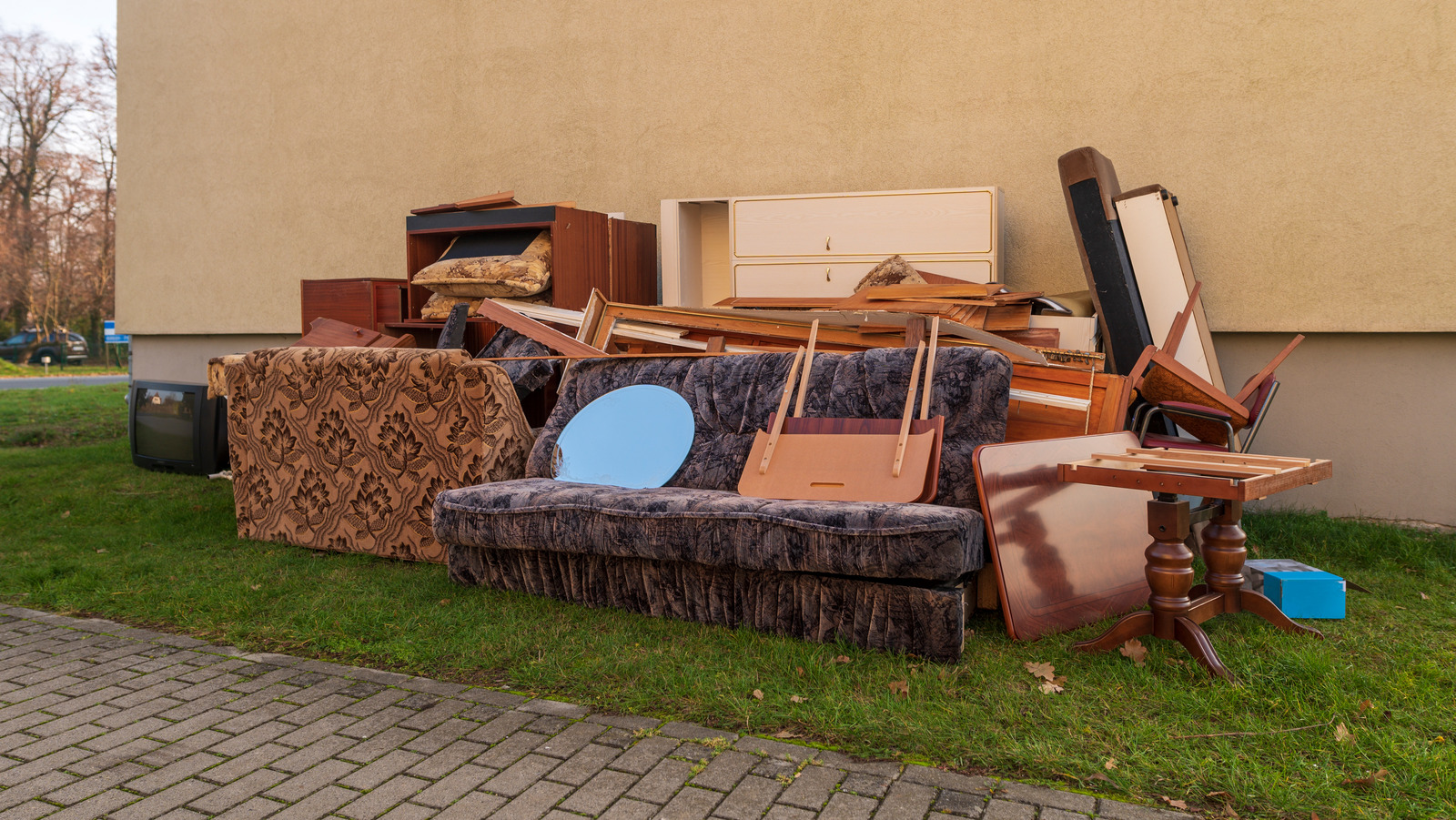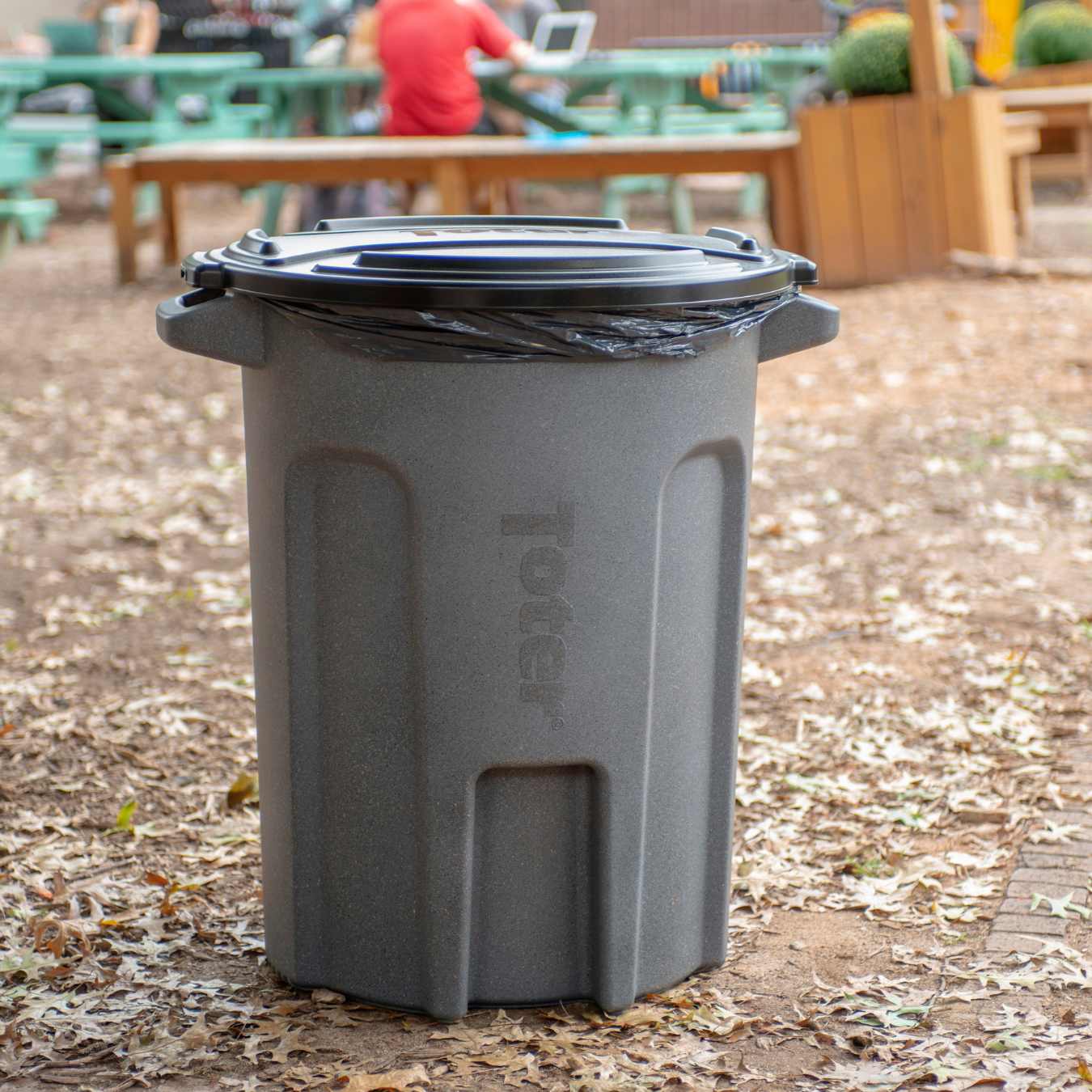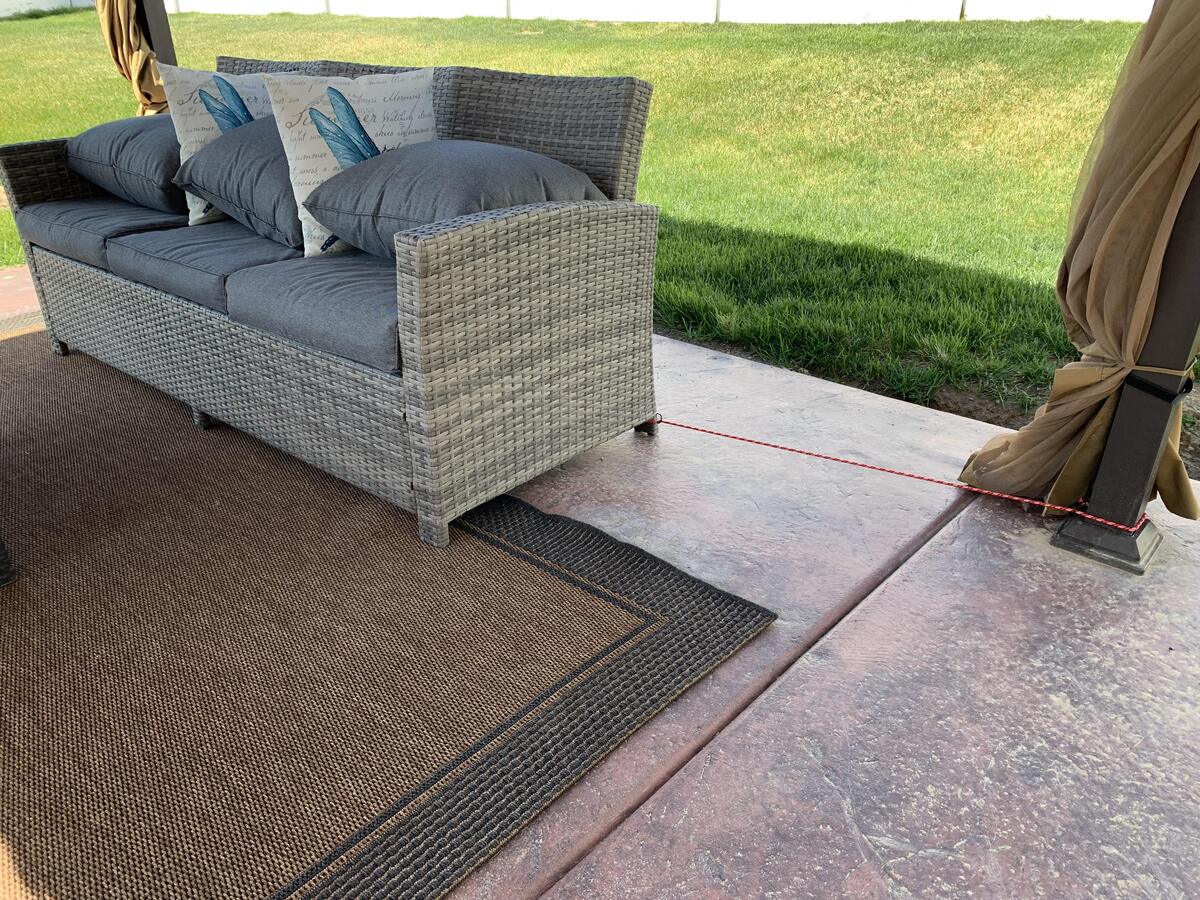

Articles
How To Throw Away Furniture
Modified: January 18, 2024
Learn how to responsibly dispose of unwanted furniture with our step-by-step guide. Safely get rid of your old furniture and make room for something new!
(Many of the links in this article redirect to a specific reviewed product. Your purchase of these products through affiliate links helps to generate commission for Storables.com, at no extra cost. Learn more)
Introduction
When it comes to furniture, there may come a time when you need to bid farewell to a beloved piece. Whether it has reached the end of its useful life, no longer fits your style, or simply needs to be replaced, properly disposing of furniture is essential. While it may seem daunting at first, with a little planning and research, you can easily find disposal options that align with your preferences and values.
In this article, we will explore various methods of disposing of furniture. We will discuss how to assess the condition of your furniture, research disposal options, and consider options such as donating, selling, recycling, arranging for curbside pickup, hiring a junk removal service, or salvaging and repurposing. By understanding these options, you can make an informed decision that is both environmentally responsible and convenient.
Key Takeaways:
- Dispose of furniture responsibly by assessing its condition, researching disposal options, and choosing methods such as donating, selling, recycling, curbside pickup, or salvaging and repurposing to minimize environmental impact.
- Give your furniture a second life through donation, recoup its value by selling, reduce waste by recycling, opt for convenient curbside pickup, or unleash your creativity by salvaging and repurposing. Choose the disposal method that aligns with your values and contributes to a sustainable future.
Read more: How To Throw Away A Mattress
Assessing the Condition of the Furniture
Before you embark on disposing of your furniture, it’s important to assess its condition. This will help you determine the best course of action to take. Start by examining the furniture for any signs of wear and tear, damage, or structural issues. Take note of any broken parts, stains, or fading upholstery.
If the furniture is in good condition, consider whether it can be useful to someone else. Perhaps a friend or family member could benefit from it, or you can donate it to a local charity or a nonprofit organization. On the other hand, if the furniture is in poor condition and beyond repair, it may be best to look into recycling or disposing of it properly to avoid any negative impact on the environment.
If the furniture is still usable but needs minor repairs, you may want to consider fixing it before disposing of it. Touching up the paint, replacing a loose screw, or getting upholstery cleaned can significantly improve its condition and make it more appealing to potential buyers or donation recipients.
Additionally, consider the age and quality of the furniture. Antique or high-quality pieces may have value to collectors or vintage furniture stores. You may want to research the market value of your furniture to see if it’s worth selling rather than simply disposing of it.
Overall, assessing the condition of your furniture will help you make an informed decision on the best disposal method. It allows you to identify whether it can be repaired, donated, sold, recycled, or salvaged for other purposes. By considering the condition and potential uses of your furniture, you can choose the most appropriate option in an environmentally-conscious manner.
Researching Disposal Options
Once you have assessed the condition of your furniture, it’s time to research the disposal options available to you. This step is crucial in finding the most suitable method for getting rid of your furniture responsibly.
Start by researching local regulations and guidelines regarding furniture disposal. Some areas have specific rules on how to dispose of furniture, and it’s important to be aware of these regulations to avoid any fines or penalties. Check with your local municipality or waste management department for information on proper disposal procedures.
Next, explore possible recycling options for your furniture. Many communities have furniture recycling programs that can divert your old furniture from the landfill and instead recycle or repurpose the materials. Look for recycling centers or specialized furniture recycling facilities in your area. They may accept different types of furniture, including wood, metal, and upholstery, and ensure that the materials are properly recycled or repurposed.
If your furniture is still in good condition, consider donating it to a charitable organization. Research local charities, shelters, or thrift stores that accept furniture donations. Many nonprofits will appreciate your contribution and put the furniture to good use. Keep in mind that some charities may have guidelines on acceptable furniture donations, so check their websites or give them a call for specifics.
Another option to explore is selling your furniture. Online platforms, such as Craigslist, Facebook Marketplace, or even local buy/sell groups, can help you connect with potential buyers. Take clear photos of your furniture, provide detailed descriptions, and set a reasonable price. Selling your furniture not only helps to recoup some of your investment but also ensures that it finds a new home where it will be appreciated.
If all else fails, consider hiring a junk removal service. These companies specialize in the removal of large household items, including furniture. They will handle the entire process for you, from hauling the furniture out of your home to properly disposing of it. Research local junk removal services and compare prices and reviews to find a reputable and reliable company.
By conducting thorough research on disposal options, you can make an informed decision that aligns with your needs and values. Whether it’s recycling, donating, selling, or utilizing a junk removal service, there are multiple avenues to responsibly dispose of your furniture, ensuring it doesn’t end up in a landfill.
Donating the Furniture
Donating your furniture is an excellent way to give it a second life and benefit those in need. By choosing to donate, you can help individuals and families who may not have the means to purchase furniture themselves. Here are some steps to follow when considering donating your furniture:
Research Local Charities: Start by researching local charities or nonprofit organizations that accept furniture donations. Look for organizations that align with causes you believe in or those that specifically focus on helping individuals or families in need. Some well-known national charities, such as Goodwill or The Salvation Army, have local branches that accept furniture donations as well.
Check Donation Guidelines: Before making a donation, check the organization’s website or give them a call to inquire about their specific donation guidelines. They may have specific requirements regarding the types of furniture they accept, the condition it should be in, and any other criteria they may have. Make sure your furniture meets their guidelines to ensure a smooth donation process.
Prepare the Furniture for Donation: Clean the furniture thoroughly before donating it. Remove any personal belongings, stickers, or labels from the furniture. If there are any minor repairs needed, consider fixing them to make the furniture more presentable and functional for the recipient.
Schedule a Pickup or Drop-Off: Many charities offer pickup services for large furniture items. Check with the organization if they have this option available. If not, you may need to arrange transportation to drop off the furniture at their designated location. Make sure to schedule the pickup or drop-off appointment in advance to ensure a smooth and convenient process.
Keep Documentation: When donating furniture, ask the organization for a receipt or acknowledgment of your donation. This can be used for tax purposes, as you may be eligible for a tax deduction for your charitable contribution. Make sure to keep the documentation in a safe place for reference when filing your taxes.
Remember, when donating furniture, you are providing much-needed support to individuals or families who may be struggling. Your contribution can help create a comfortable and welcoming living space for those in need. It’s a rewarding way to give back to your community while ensuring your furniture finds a new home where it will be appreciated.
Selling the Furniture
If your furniture is in good condition and you’re looking to recoup some of its value, selling it can be a great option. There are various avenues you can explore to sell your furniture and find interested buyers. Here are some steps to consider when selling your furniture:
Assess the Market Value: Before setting a price for your furniture, research its market value. Look at similar items being sold online or in local stores to get an idea of what to expect. Take into account factors such as age, condition, and brand to determine a fair and competitive price.
Choose the Right Selling Platform: There are numerous platforms where you can sell your furniture, both online and offline. Online platforms such as Craigslist, Facebook Marketplace, or specialized furniture selling websites provide a wide reach and convenience. Offline options include local consignment shops or hosting a yard sale. Consider your target audience and the type of marketplace that suits your needs best.
Take High-Quality Photos: To attract potential buyers, take clear, well-lit photos of your furniture from different angles. Highlight any unique features or details. Including measurements in the description can also be helpful for buyers to gauge whether the furniture will fit their space.
Write a Compelling Description: Craft a persuasive and detailed description of your furniture. Highlight its key features, materials, and any special characteristics. Be honest about the condition of the furniture and mention any imperfections or wear. Include information about the age and brand of the furniture, if known.
Promote Your Listing: Once your listing is live on your chosen selling platform, take steps to promote it. Share the listing on social media platforms, online forums, and local community groups. Encourage friends and family to spread the word. The more visibility your listing gets, the higher the chances of finding potential buyers.
Communicate and Negotiate: When inquiries or offers start coming in, be responsive and courteous in your communication. Answer any questions potential buyers may have promptly. If negotiating the price, be open to reasonable offers and find a mutually beneficial agreement.
Arrange for Pickup or Delivery: Once you have finalized the sale, make arrangements for the pickup or delivery of the furniture. Determine who will be responsible for transportation and discuss logistics with the buyer. Ensure the process is smooth and convenient for both parties.
By selling your furniture, you can put some extra money in your pocket and ensure that the piece finds a new home where it will be appreciated. It’s a win-win situation, providing value to both you and the buyer.
When throwing away furniture, consider donating it to a local charity or thrift store if it’s still in good condition. If it’s not usable, check with your local waste management company for proper disposal options.
Read more: How To Throw Away Broken Glass
Recycling the Furniture
When your furniture is no longer in usable condition or cannot be donated or sold, recycling is a responsible option to consider. Recycling helps to divert materials from the landfill, reduce environmental impact, and promote sustainability. Follow these steps to recycle your furniture:
Research Local Recycling Facilities: Start by researching local recycling facilities that accept furniture. Look for specialized furniture recycling centers or recycling programs in your area. These facilities are equipped to properly handle and process different materials like wood, metal, and upholstery.
Check Recycling Guidelines: Before taking your furniture to a recycling facility, check their guidelines and requirements. Some facilities may have specific instructions on how to prepare the furniture for recycling. For example, they may require you to disassemble the furniture or separate different materials.
Prepare the Furniture for Recycling: Remove any non-recyclable parts from the furniture, such as foam cushions or plastic components. Separate the materials into different categories, such as wood, metal, and fabric, if the recycling facility requires it. This will help streamline the recycling process and ensure that the materials can be properly recycled or repurposed.
Transport the Furniture to the Recycling Facility: Depending on the size and weight of the furniture, you may need to arrange for transportation to the recycling facility. If the furniture is too large to fit in your vehicle, consider renting a truck or hiring a local moving company to transport it for you. Make sure to secure the furniture properly to avoid any damage during transport.
Follow Proper Disposal Procedures: When you arrive at the recycling facility, follow their instructions for disposal. They may have designated drop-off areas or specific procedures to follow. Ensure that you comply with their requirements to ensure a seamless recycling process.
Explore Upcycling or Repurposing Opportunities: In some cases, certain parts of your furniture may have the potential for upcycling or repurposing. For example, wooden parts can be turned into DIY projects, and fabric can be used for upholstery or craft projects. Consider saving these components and find creative ways to give them a new life instead of sending them for recycling.
Recycling your furniture is a responsible choice that minimizes waste and contributes to a more sustainable future. By finding a local recycling facility and following their guidelines, you can ensure that your furniture is properly processed and the materials are reused or repurposed in an eco-friendly manner.
Arranging for Curbside Pickup
If you’re looking for a convenient and hassle-free way of disposing of your furniture, arranging for curbside pickup can be an excellent option. Many waste management companies or local municipalities offer curbside pickup services for large items like furniture. Here’s how you can arrange for curbside pickup:
Check Local Requirements: Start by checking with your local waste management company or municipality to determine if they offer curbside pickup services for furniture. Review any guidelines or requirements they may have, such as scheduling appointments, preparing the furniture for pick up, or adhering to specific disposal protocols.
Schedule the Pickup: Once you have confirmed that curbside pickup is available, schedule a pickup appointment. Contact the waste management company or municipality to arrange a date and time for the pickup. Provide them with any necessary information they may require, such as the type and quantity of furniture you need to dispose of.
Prepare the Furniture: Before the scheduled pickup, prepare your furniture for curbside collection. Depending on the local requirements, this may involve disassembling the furniture, removing any attachments, or ensuring that it’s bundled or wrapped securely for easy handling. Follow any instructions provided by the waste management company or municipality to ensure a smooth pickup process.
Place the Furniture at the Designated Spot: On the designated pickup day, place the furniture at the designated spot per the instructions provided. Typically, this is at the curb or a specific location specified by the waste management company. Make sure the furniture is easily accessible and visible to the collection team to avoid any delays or confusion.
Dispose of the Furniture Responsibly: Once the collection team has picked up the furniture, rest assured that it will be disposed of properly. Waste management companies often have protocols in place to ensure that the furniture is either recycled, donated, or disposed of in an environmentally responsible manner. This way, you can contribute to reducing landfill waste and minimizing the environmental impact of your furniture disposal.
Follow Any Additional Instructions: Depending on your local regulations, there may be additional instructions to follow, such as filling out forms or paying a fee for curbside pickup. Make sure to comply with these requirements to avoid any complications and ensure a seamless disposal process.
Arranging for curbside pickup is a convenient option for disposing of furniture without the need for transportation or additional expenses. By working with your local waste management company or municipality, you can ensure that your furniture is collected and disposed of in a responsible manner while adhering to local guidelines and requirements.
Hiring a Junk Removal Service
If you prefer a hassle-free and efficient method of getting rid of your furniture, hiring a junk removal service can be a convenient option. These professionals specialize in the removal and disposal of large items, including furniture. Here are some steps to consider when hiring a junk removal service:
Research Local Junk Removal Companies: Start by researching local junk removal companies in your area. Look for reputable service providers with positive customer reviews and ratings. Consider asking for recommendations from friends, family, or neighbors who have used similar services in the past.
Request Quotes and Compare Prices: Contact multiple junk removal companies and request quotes for the removal of your furniture. Provide them with details about the type and quantity of furniture you need to dispose of. Compare the prices and services offered by different companies to find the one that best fits your needs and budget.
Inquire about Licensing and Insurance: Before hiring a junk removal service, inquire about their licensing and insurance. Make sure they are a legitimate and registered company. Additionally, ensure that they have liability insurance to protect against any potential damages or accidents that may occur during the removal process.
Ask About Responsible Disposal: Find out how the junk removal service handles the disposal of the furniture. Ideally, you want to work with a company that prioritizes environmentally friendly disposal methods. Ask if they recycle or donate items whenever possible to minimize waste and promote sustainability.
Schedule the Pickup: Once you have chosen a junk removal company, schedule a pickup appointment at a convenient date and time. The company will typically provide you with a time window for their arrival. Make sure that someone is available to grant them access to your furniture for removal.
Ensure Accessibility: Clear a path for the junk removal team to access the furniture. Remove any obstacles or clutter that may hinder their ability to remove the items efficiently. If the furniture is located in a difficult-to-reach area, notify the company in advance so they can come prepared with the necessary equipment.
Review the Terms and Conditions: Before finalizing the agreement, carefully review the terms and conditions provided by the junk removal company. Pay attention to any restrictions or requirements they may have, such as prohibited items or additional charges for special services. Make sure you fully understand the terms before proceeding.
Hiring a junk removal service takes the burden off your shoulders and ensures that your furniture is removed and disposed of properly. By working with professionals, you can save time, effort, and stress associated with arranging transportation, disposal, and potential heavy lifting. It’s a convenient option that allows you to focus on other aspects of your furniture disposal process.
Salvaging or Repurposing the Furniture
If your furniture is no longer in usable condition but you’re not ready to part ways with it completely, salvaging or repurposing it can be a creative and sustainable option. By giving your furniture a new purpose or transforming it into something else, you can extend its lifespan and minimize waste. Here are some ideas to consider:
Repair and Restore: Assess the furniture to determine what repairs are needed. Whether it’s fixing a broken leg, repairing upholstery, or refinishing the surface, investing time and effort into restoring the piece can bring it back to life. Seek guidance from online tutorials, DIY books, or consult with professionals if needed.
Transform into a Different Function: Consider repurposing the furniture by giving it a new function. For example, an old wooden dresser can be turned into a stylish bathroom vanity, or a coffee table with damaged legs can be transformed into a trendy bench. Get creative and think outside the box to find a new purpose for your furniture.
Upcycle the Materials: If the furniture cannot be salvaged as a whole, you can still upcycle its individual parts and materials. For instance, wooden parts can be used to create wall décor, shelves, or even a headboard for a bed. Upholstery fabric can be repurposed into pillows, cushion covers, or even used for craft projects.
Donate for Upcycling Projects: Consider donating your furniture or its parts to organizations or individuals who specialize in upcycling projects. This way, they can repurpose the materials and create new and unique pieces from them. Look for local craft collectives, upcycling workshops, or artists who may be interested in your furniture for their projects.
Host a Furniture Swap or Giveaway: If you’re not sure how to repurpose the furniture yourself, organize a furniture swap event or give it away for free. This way, someone else may have the skills or desire to salvage or repurpose the furniture. It’s a great way to contribute to a circular economy and ensure that the furniture gets a new lease on life.
Get Inspired by DIY Projects: Take inspiration from online platforms, magazines, or books dedicated to DIY projects and furniture upcycling. Explore tutorials and step-by-step guides to learn new techniques and ideas for salvaging or repurposing furniture. The possibilities are endless, and you may discover a new passion for creative and sustainable design.
Salvaging or repurposing your furniture not only reduces waste but also allows you to showcase your creativity and create unique pieces with sentimental value. By giving your furniture a new purpose, you can continue to enjoy its presence in your home while reducing your environmental footprint.
Read more: How To Throw Away Grass Clippings
Conclusion
When it’s time to say goodbye to your furniture, it’s important to consider the best disposal options that align with your values and circumstances. Assessing the condition of your furniture helps determine if it can be repaired, donated, sold, recycled, or salvaged for other purposes. Researching disposal options allows you to find the most suitable method, whether it’s arranging for curbside pickup, hiring a junk removal service, or exploring opportunities for donation and recycling.
Donating your furniture is an excellent way to help those in need and give your furniture a second life. Selling it can help recoup some of its value while ensuring it finds a new home where it will be appreciated. Recycling your furniture reduces waste and promotes sustainability by diverting materials from the landfill. Arranging for curbside pickup offers convenience, while hiring a junk removal service takes the burden off your shoulders and ensures proper disposal.
If you’re feeling creative and want to explore sustainable alternatives, consider salvaging or repurposing your furniture. Repair and restore it, give it a new function, or upcycle its materials into unique creations. By thinking outside the box and staying inspired by DIY projects, you can breathe new life into your furniture and minimize waste.
Remember, every piece of furniture has a story, and it’s important to handle its disposal responsibly. By choosing the right disposal method, you contribute to a more sustainable future and ensure that your furniture doesn’t end up in a landfill unnecessarily.
So, the next time you are faced with the challenge of disposing of furniture, take the time to assess its condition, research your options, and make a choice that aligns with your values. Whether you donate, sell, recycle, arrange for curbside pickup, or salvage and repurpose, you can have peace of mind knowing that you have made a conscious decision that benefits both your immediate environment and the world at large.
Frequently Asked Questions about How To Throw Away Furniture
Was this page helpful?
At Storables.com, we guarantee accurate and reliable information. Our content, validated by Expert Board Contributors, is crafted following stringent Editorial Policies. We're committed to providing you with well-researched, expert-backed insights for all your informational needs.














0 thoughts on “How To Throw Away Furniture”